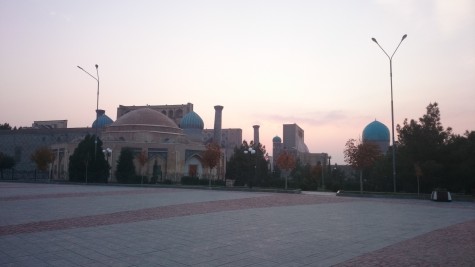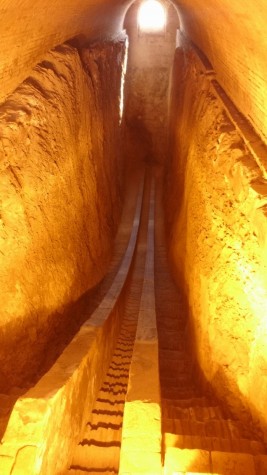OK, back to those train tickets. Once again, we walked to the tourist information office. This time they were open. Yes! But they didn’t sell tickets. No! But they did tell us that a train ticket office was on the other side of town, back in the direction of the hostel. Eh. The nice woman strongly suggested we buy the tickets as soon as possible in case they sold out. That left us no choice but to walk all the way back and then some to buy our tickets.
With our tickets finally purchased, we could finally start our day’s sightseeing. Of course, where we wanted to visit was back in the direction of the tourist information office. So, for the third time, we walked towards the tourist information office. This time, we walked past it, past the Avenue of the Mausoleums, and into ancient Samarkand.
Though Samarkand’s glory days came during Temur, it was an important city long before Temur. Genghis Khan, after all, pillaged it, so there must have been something to pillage. That something is now called Afrosiyab, an archaeological site with an eponymous museum. The museum itself was nothing special, containing some ceramics and tools unearthed at the site. The highlight was a semi-restored fresco that showed traders from Europe and Asia paying their respects to Samarkand’s leadership.
Past the museum was the tomb of the Prophet Daniel. Legend has it that he keeps growing even in his death. His coffin is currently about 20 feet long. Cindy and I debated what exactly happens when they need a new coffin, and a new building in which the coffin is placed.
Even farther is something not from ancient Samarkand at all. Ulugbek, grandson of Temur, was a noted astronomer. Surprise surprise, he had an observatory. And it was in Samarkand. If I knew more about astrology I could probably describe its importance more, but apparently it was one of the more remarkable finds in recent history. The remains indicate that his telescope was enormous and lent some context to his remarkably accurate findings, published 600 years ago. For example, he accurately calculated the exact length of a solar year.
We bid adieu to Samarkand with an Uzbek dinner at a neighborhood restaurant. Cindy mentioned in her most recent post that we are usually not seen as a married couple, and that a few Uzbek men took that interpretation to another level during dinner. Not perceiving us in this manner is not solely confined to Uzbekistan. Our hostel in Hong Kong saw us and asked, “friends?” No, I’m just some random dude she found on the elevator ride and decided to share a room with. After seeing our double bed reservation, she had a quizzical look and asked, tentatively, “couple?” At least she asked, Other hostels and hotels just give us two beds without inquiring.
For the record, this is not just because we are a mixed race couple, so get that explanation out of your head. It’s because I’m an Asian male and she’s a non-Asian female. If the races, or the genders, were reversed (i.e., she’s an Asian female and I’m a non-Asian male), then the chances of us being mistaken for a non-couple would be much lower. Especially in a place like Hong Kong. If you don’t know this by now, and that’s unlikely if you know me, Asian men are regarded as non-threatening, passive, sexual non-entities. We’re barely background noise as far as couplings are concerned. That three Uzbek men saw me with Cindy, did not think we were together, and were not threatened by my presence is not novel. It happens everywhere I go with everyone I’m around. It’s just life. And now Cindy’s part of that life.

 Español
Español

